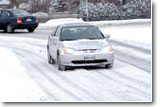 |
Safe Winter Travel
 Stay alert, slow down and stay in control — the three key things you can do for safe
winter driving. Drive according to current road and weather conditions. Stay alert, slow down and stay in control — the three key things you can do for safe
winter driving. Drive according to current road and weather conditions.
Be Prepared! Get your vehicle winter-ready with a
maintenance check-up. Don't wait for winter to have your battery, belts, hoses,
radiator, oil, lights, brakes, exhaust system, heater/defroster, wipers, and ignition
system checked.
The condition of your vehicle's tires is important. Worn and damaged tires can
hamper your ability to drive safely. Have them checked or replaced before winter
begins. Remember to check tire air pressure frequently, as it decreases in
colder weather.
While regular or "all-season" tires, including wide and high-performance
tires, may be adequate in some areas, they may not be suitable for use on snow
covered roads. Winter tires improve driving safety by providing better traction
and handling through snow, slush, and on ice.
Installing four winter tires provides greater control and stability. Never mix
tires of different tread, size and construction.
Useful Tips!
- Check weather and travel conditions before heading out.
Don't take chances if the weather is bad. Allow yourself extra time for travel,
or wait until conditions improve.
- Carry a winter travel
kit for long road trips.
- If you are traveling a long distance, plan your route ahead of time.
Let someone know of your destination and expected time of arrival.
- Wear comfortable clothing that doesn’t restrict your movement
while at the wheel. Keep warm clothing for getting out of your vehicle.
- Clear snow and ice from all windows, lights, mirrors, and the
roof. After starting your vehicle, wait for the fog to clear from the
interior of the windows so you will have good visibility all around.
- Make sure your vehicle is mechanically ready for the rigours
of winter and keep your gas tank sufficiently full — at least a half of
a tank is recommended.
- Make sure you have sufficient windshield washer fluid in the
reservoir and that it is rated in the -40°C temperature range. Keep an
extra jug in the vehicle.
- Use a cell phone only when necessary. When you need help, pull well off of
the road to make or receive a call.
Winter Weather
 Ah, Canadian weather! We get it all here: rain, snow, sunshine... sometimes all on the same day.
Ah, Canadian weather! We get it all here: rain, snow, sunshine... sometimes all on the same day.
Winter weather conditions in Canada can become severe or dangerous very
quickly, sometimes with little or no warning.
High windchills,
heavy snowfall, freezing rain, blizzards and extremely cold temperatures all pose a hazard to
those travelling or venturing outside.
The following general precautions outline how to minimize the effects of
winter weather and prepare in advance for severe weather conditions.
Dress to suit the weather:
Thin layers of loose fitting clothing will trap body heat while aiding air
circulation. Outer clothing should be hooded, tightly woven, and repel water.
Mittens are warmer than gloves. It is important to wear a hat because most body
heat is lost through the head. If it is extremely cold, cover your mouth to
protect your lungs from the cold air.
Watch for signs of Cold Injuries:
Which is particularly threatening to the very young and elderly. Feeling
cold over a prolonged period of time can cause a drop in body temperature below
the normal 37°C. Symptoms of hypothermia are shivering, confusion, and loss of
muscular control. If symptoms occur, get medical assistance immediately.
Hypothermia can progress to a life threatening condition where shivering
stops, the person loses consciousness and cardiac arrest can occur.
Check the weather forecast before
going outdoors or travelling:
Pay particular attention to
windchill,
which can create dangerously cold outdoor conditions.
Winterize your home and vehicle before the cold weather arrives:
Prepare an emergency pack for your home and vehicle and ensure your home heating
system is in good working order. Insulate your home to avoid cold air leaks and
minimize heating costs.
Pace your outdoor activity:
Be alert for signs of frostbite. Avoid strenuous activity in extremely cold
temperatures because the heart must work harder to pump blood through
constricted vessels in arms and legs.
Did you know?
- Every year, Environment Canada issues 14,000 warnings and 1,100,000
forecasts
- On a driveway measuring 15 metres by four metres, 40 centimetres of heavy,
wet snow weighs 12 tonnes!
|

